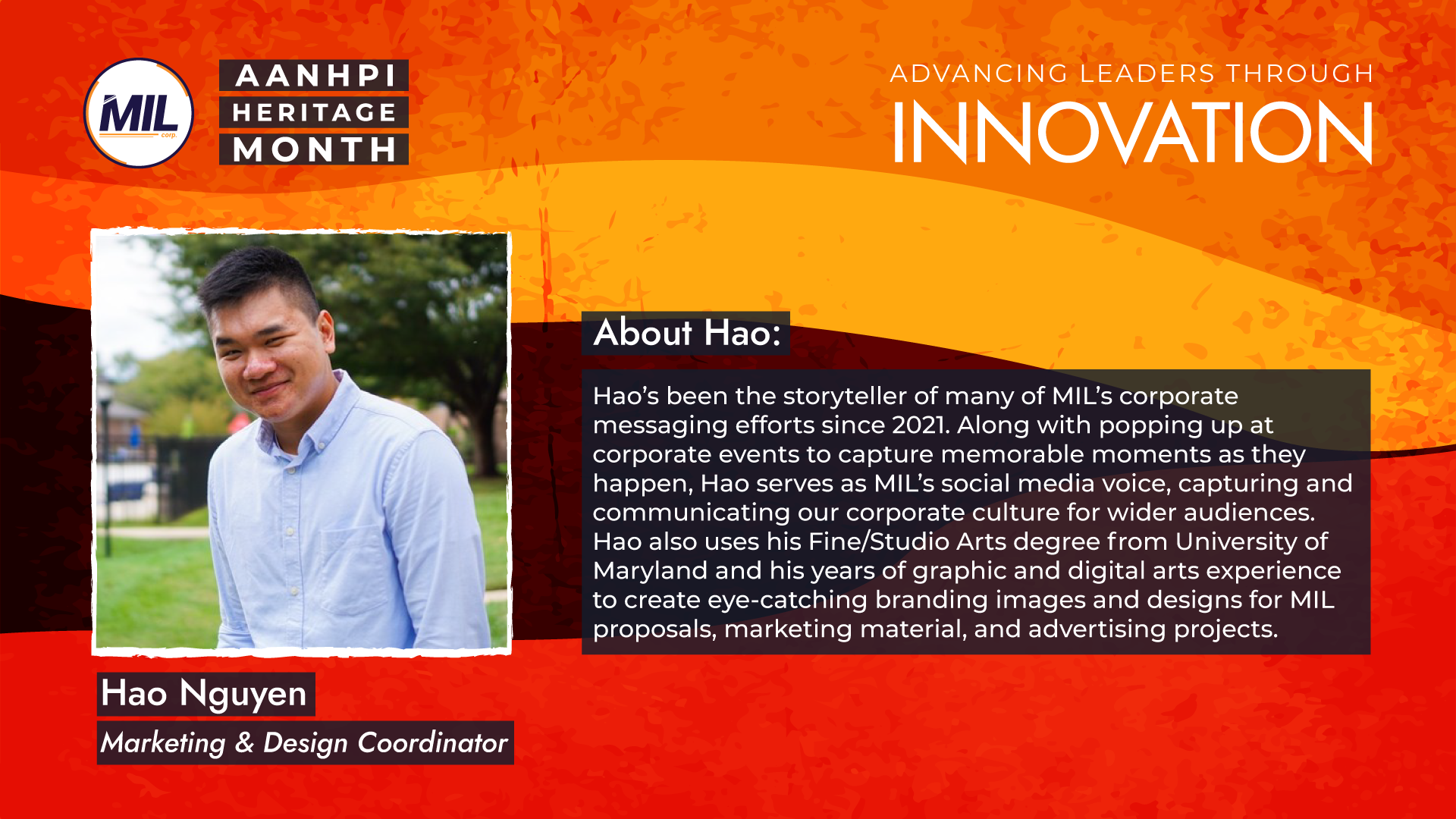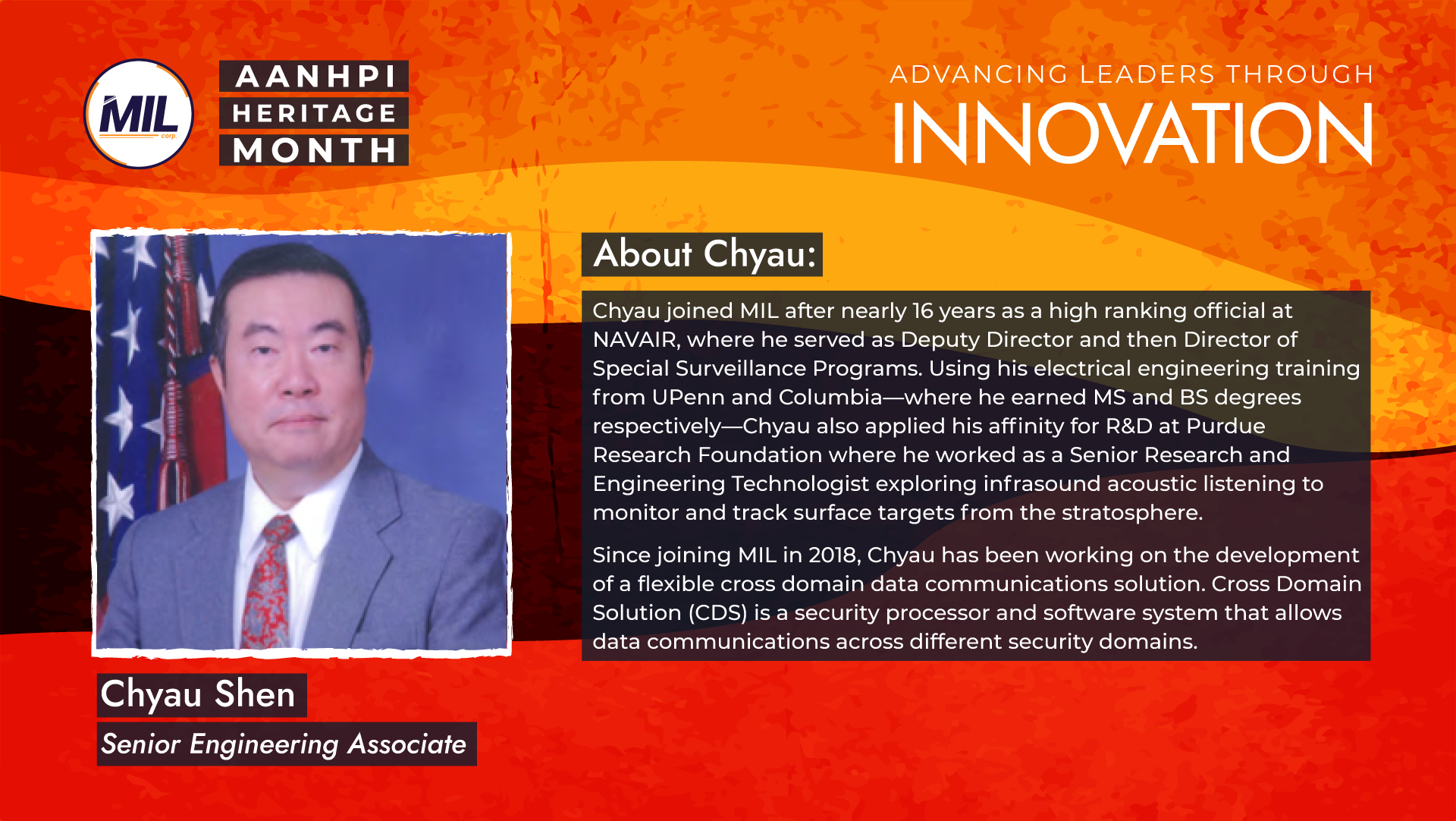AANHPI difference makers
To honor Asian American, Native Hawaiian, and Pacific Islander (AANHPI) Heritage Month 2024, all this month thought leaders representing MIL’s business sectors and different parts of the AANHPI community, reflect on the achievements of a handful of AANHPI innovators that have advanced our collective understanding of the world around us and changed our lives for the better. The AANHPI community hails from 50 diverse ethnic groups speaking over 100 different languages, and this year MIL focuses on four AANHPI trailblazers that have entertained us, kept us safer, protected our digital assets, and helped girls and young women envision a future in STEM. Join us at MIL as we recognize and celebrate the contributions of AANHPI leaders in innovation.
___________________________

Saying something with video
YouTube co-founder and AANHPI innovator Steven Chen famously said, “Every user has something to say,” and on February 14th, 2005, Chen and fellow AANHPI computer scientist Jawed Karim, along with third co-founder Chad Hurley, provided one of the most famous places for everyday users to make a statement. After first meeting in 2002 while working at PayPal, Taiwanese American Chen and Karim (of Bangladeshi and German descent) discovered they were both comp sci graduates from the University of Illinois at Urbana-Champaign, and both possessed a distinctly American entrepreneurial spirit. Once teamed up, that combined drive to create led to the launch of YouTube, the first and most famous video-sharing platform.
YouTube’s first video posted by Karim (“Me at the Zoo”) has been viewed over 310 million times since its April 23, 2005, debut (and add one more if you clicked on the link). Although Chen, Karim, and Hurley no longer head YouTube—since they sold the platform to Google in 2006 for an astounding $1.65 billion—the company is currently under the leadership of yet another AANHPI innovator, Indian American electrical engineer and Google Chief Product Officer Neal Mohan.
By YouTube’s own estimates, 500+ hours of video content is uploaded every minute by users in 100+ countries worldwide using 80 different languages. The sheer volume of users invites the question, Why? What is it about the melding of audiovisual imageries with user imaginings that compels a worldwide audience of over a billion people to tune in every day? To gain some insight, we asked MIL’s own creative innovator Marketing & Design Coordinator Hao Nguyen to explain video’s widescale appeal.
Why is video so much more compelling than text or graphics alone?
Hao: Video combines visual and auditory elements which can be more captivating than static text or graphics. Using music, storytelling, and visual imagery, even the simplest instructional videos can create a deeper emotional connection with the audience, making the content more memorable. Also, certain concepts are easier to demonstrate or explain through video. Whether it’s showcasing a product in action, demonstrating a process, or providing a step-by-step tutorial, videos can effectively convey complex information in a clear and concise manner. I think videos are inherently more compelling because of how dynamic you can make them, combined with the ability to engage viewers, and convey information in a compelling way, it’s a powerful medium for communication and storytelling.
So, is that why it’s easier to “message” using video (as TV advertisers have known for years)?
Hao: Videos, even without audio, leverage the power of visual communication to inform and explain in a way that is engaging, accessible, and emotionally compelling. Viewers can process visuals faster than they can with text, so visuals allow for quick absorption of information and facilitate understanding. Through imagery, charts, graphs, and animations, complex concepts can be simplified and explained more effectively than with text alone. A well-constructed instructional video can transcend language barriers and can be understood by people from different cultural backgrounds. This universal appeal makes it an effective tool for communication and persuasion across diverse audiences.
What about retention? Are people remembering messages better or just being more entertained?
Hao: Videos tend to have higher retention rates because of all the reasons I’ve presented. By engaging the visual and auditory senses of the viewers, they are immediately more connected to the content. This connection enhances memory retention, as people are more likely to remember content that elicits an emotional response. Again, humans are inherently visual creatures, and we process moving visuals more quickly and effectively than text.
My favorite videos to make are the post-event videos we produce for our Award Ceremonies. These videos are a montage of images and footage captured during the event, set to uplifting music. By showcasing our employees enjoying themselves with their families, these videos create a vibrant and engaging narrative. The combination of visuals and music fosters a sense of excitement and celebration, making the content highly memorable and shareable. Ultimately, these videos are successful because they authentically capture the joy and camaraderie of our team members, resonating with viewers on a personal level.
About Hao
Hao’s been the storyteller of many of MIL’s corporate messaging efforts since 2021. Along with popping up at corporate events to capture memorable moments as they happen, Hao serves as MIL’s social media voice, capturing and communicating our corporate culture for wider audiences. Hao also uses his Fine/Studio Arts degree from University of Maryland and his years of graphic and digital arts experience to create eye-catching branding images and designs for MIL proposals, marketing material, and advertising projects. Before joining the company, Hao served in several other creative positions including as a Digital Marketing Coordinator for the Maryland Technology Development Corporation.
___________________________

Improving US remote sensing capabilities
Tian Ma is a computer scientist, a principal member of the Sandia Labs technical staff, and the Chinese Institute of Engineers-USA (CIE) 2023 Asian American Engineer of the Year. In 2003, Ma joined a Sandia Labs university fellowship program that ultimately earned him both a master’s degree in electrical and computer engineering and a doctorate in systems engineering. At Sandia, Ma focuses his R&D efforts on edgy technical areas such as data analytics and data fusion, decision science, computer vision (a branch of AI devoted to identifying and understanding objects and people), and remote sensing. Over his last dozen years at Sandia, Ma has developed numerous innovative detection and tracking algorithms for remote sensing systems under the Lab’s nuclear non-proliferation program and national security missions.
Some of Ma’s most ambitious work has focused on designing algorithms to better detect and track the movement of objects and has led to advancements in multiple hypothesis tracking (MHT) and jitter suppression. Ma’s innovative work has enabled U.S. government agencies to pursue entirely new remote sensing missions that have enhanced national security interests. Read on to learn a little bit about sensor jitter from MIL Senior Engineering Associate Chyau Shen—what is it, what causes it, and why is suppressing it so vital to our national interests?
What is sensor jitter and what causes it?
Chau: Sensor jitter is the distortion and loss of sensor data fidelity due to the sensor carrying platform motion dynamics or data communications system disturbances. At the platform level, sensor jitter is caused by platform dynamics such as sudden motion (e.g., going over road “bumps”), vibration due to engine or atmosphere turbulence. At the data communications system level, sensor jitter is caused by degradation of synchronization of data packets due to electromagnetic interference, cross talk, or equipment noise. This results in the data receiver processor’s inability to truly reconstruct the sensor imagery/data.
Why is jitter suppression important to sensor performance?
Chau: Sensor jitter reduces the resolution of optical sensors and sometimes renders the collected imagery useless. For radio frequency (RF) sensors, jitter results in the loss of vital signal and RF intelligence data. Thus, it is vital to suppress sensor jitter. For national security, the ability to collect vital intelligence imagery and signal data for intelligence analysis, operational actions, and protection of forces and citizens will be seriously hampered by sensor jitter.
Any personal experience with jitter suppression?
Chau: While at NAVAIR, I had to deal with a serious sensor jitter incident and find ways to quickly resolve it. During Operation Enduring Freedom, the Joint Staff initiated a Counter IED Blitz in Theater to find airborne means of finding and identifying IEDs [improvised explosive devices] along convey routes. To identify the IED, it had to be imaged with a stringent resolution requirement and the imagery data had to be sent via satellite to CONUS intelligence and command centers for analysis and action. In response, I developed and deployed a low flying UAV system that had an affordable stabilized video surveillance sensor. Since the UAV flies at low altitudes (about 2,000 ft above ground), the optical magnification required to solve the IED is factors smaller than manned aircraft and therefore did not require sophisticated platform jitter removal mechanism. However, during actual operational flights, the video imagery was seriously corrupted by jitter through the satellite communications channel. Due to urgency, a solution had to be found quickly. Through analysis of the mission scenario, I realized that, since the IED is fixed on the ground, conventional full motion video sensor requiring very tight data packet synchronization is not needed. A relatively simple innovation was initiated to resolve the jitter issue. I had the team modify, ruggedize, and integrate with UAV avionics a newly released inexpensive hobby digital camera with the UAV. The digital framing camera takes snapshots and “freeze frame” target imagery, which mitigates platform jitter and produced high resolution imagery such as the ability to identify the wristwatch on a USMC soldier riding in a convoy vehicle. And, by sending only digital frame imagery, there was no data packet synchronization and jitter issues and the full fidelity of the camera imagery was seen at CONUS command centers.
About Chyau
Chyau joined MIL after nearly 16 years as a high ranking official at NAVAIR, where he served as Deputy Director and then Director of Special Surveillance Programs. Using his electrical engineering training from UPenn and Columbia—where he earned MS and BS degrees respectively—Chyau also applied his affinity for R&D at Purdue Research Foundation where he worked as a Senior Research and Engineering Technologist exploring infrasound acoustic listening to monitor and track surface targets from the stratosphere.
Since joining MIL in 2018, Chyau has been working on the development of a flexible cross domain data communications solution. Cross Domain Solution (CDS) is a security processor and software system that allows data communications across different security domains.
To learn more about Chyau’s innovative work in CDS, make sure to check out our next issue of the MIL Connection.
